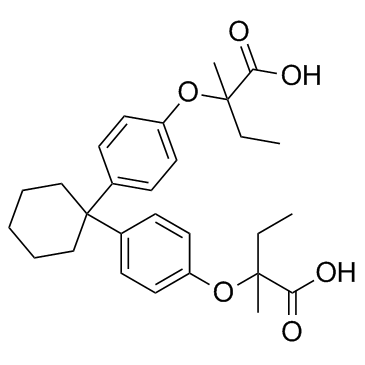30299-08-2
| Name | Clinofibrate |
|---|---|
| Synonyms |
UNII:0374EZJ8CU
2-[4-[1-[4-(2-carboxybutan-2-yloxy)phenyl]cyclohexyl]phenoxy]-2-methylbutanoic acid 2,2'-[1,1-Cyclohexanediylbis(4,1-phenyleneoxy)]bis(2-methylbutanoic acid) 2,2'-[cyclohexane-1,1-diylbis(benzene-4,1-diyloxy)]bis(2-methylbutanoic acid) Butanoic acid, 2,2'-[cyclohexylidenebis(4,1-phenyleneoxy)]bis[2-methyl- 2,2'-[Cyclohexane-1,1-diylbis(4,1-phenyleneoxy)]bis(2-methylbutanoic acid) MFCD00865769 |
| Description | Clinofibrate (S-8527) is a hypelipidemic agent and a HMG-CoA reductase inhibitor. |
|---|---|
| Related Catalog | |
| In Vivo | Clinofibrate administration (50 and 100 mg/kg/day, p.o.) significantly inhibits the increase in plasma fibrinogen level as well as serum- and VLDL-LDL-lipids[1]. Clinofibrate significantly decreases the high plasma cholesterol level of atherosclerotic rats, which is 823±256 mg/dl, or about ten times that of control rats (85±11 mg/dl). On treatment with clinofibrate, the cholesterol level is reduced most in the very low density lipoprotein (VLDL) fraction[2]. In rats which are refed either a fat-free diet or a 5% fat diet after a 2-day fast. clinofibrate at 30 mg/kg results in reductions of serum and liver triglyceride levels[3]. Oral ingestion of S-8527 to normal rats for 7 days lowers serum triglycerides and cholesterol by about 27% at 1 mg/kg and 20% at 3 mg/kg, respectively. S-8527 at 3 mg/kg decreases liver triglyceride concentration by about 20%[4]. |
| Animal Admin | Rats: Male Wistar rats weighing 100-160 g are used. S-8527 and clofibrate are suspended in an appropriate amount of 5 gum arabic solution so that the daily dose would be 0.5 mL per 100 g of body weight. The drugs are given to the rats via stomach tube every a.m. for 7 days. Control groups are on an equal volume of vehicle. During the experimental period, the animals are fed on a commercial chow pellet ad libitum. About 24 hr after the last dose, the rats are anesthetized with ether and blood samples are obtained from the inferior venacava. After sacrifice, the livers are removed, washed with physiological saline, blotted on filter paper and weighed[4]. |
| References |
| Density | 1.2±0.1 g/cm3 |
|---|---|
| Boiling Point | 613.8±55.0 °C at 760 mmHg |
| Melting Point | 143-145°C |
| Molecular Formula | C28H36O6 |
| Molecular Weight | 468.582 |
| Flash Point | 198.1±25.0 °C |
| Exact Mass | 468.251190 |
| PSA | 93.06000 |
| LogP | 6.71 |
| Vapour Pressure | 0.0±1.9 mmHg at 25°C |
| Index of Refraction | 1.559 |
| Storage condition | Refrigerator |
|
Material Safety Data Sheet
Section1. Identification of the substance Product Name: Clinofibrate 2-(4-{1-[4-(1-carboxy-1-methylpropoxy)phenyl]cyclohexyl}phenoxy)-2-methylbutanoic acid Synonyms: Section2. Hazards identification Harmful by inhalation, in contact with skin, and if swallowed.
Section3. Composition/information on ingredients. Ingredient name:Clinofibrate CAS number:30299-08-2 Section4. First aid measures Skin contact:Immediately wash skin with copious amounts of water for at least 15 minutes while removing contaminated clothing and shoes. If irritation persists, seek medical attention. Eye contact:Immediately wash skin with copious amounts of water for at least 15 minutes. Assure adequate flushing of the eyes by separating the eyelids with fingers. If irritation persists, seek medical attention. Inhalation:Remove to fresh air. In severe cases or if symptoms persist, seek medical attention. Ingestion:Wash out mouth with copious amounts of water for at least 15 minutes. Seek medical attention. Section5. Fire fighting measures In the event of a fire involving this material, alone or in combination with other materials, use dry powder or carbon dioxide extinguishers. Protective clothing and self-contained breathing apparatus should be worn. Section6. Accidental release measures Personal precautions: Wear suitable personal protective equipment which performs satisfactorily and meets local/state/national standards. Respiratory precaution:Wear approved mask/respirator Hand precaution:Wear suitable gloves/gauntlets Skin protection:Wear suitable protective clothing Eye protection:Wear suitable eye protection Methods for cleaning up: Mix with sand or similar inert absorbent material, sweep up and keep in a tightly closed container for disposal. See section 12. Environmental precautions: Do not allow material to enter drains or water courses. Section7. Handling and storage Handling:This product should be handled only by, or under the close supervision of, those properly qualified in the handling and use of potentially hazardous chemicals, who should take into account the fire, health and chemical hazard data given on this sheet. Store in closed vessels, refrigerated. Storage: Section8. Exposure Controls / Personal protection Engineering Controls: Use only in a chemical fume hood. Personal protective equipment: Wear laboratory clothing, chemical-resistant gloves and safety goggles. General hydiene measures: Wash thoroughly after handling. Wash contaminated clothing before reuse. Section9. Physical and chemical properties Appearance:Not specified Boiling point:No data No data Melting point: Flash point:No data Density:No data Molecular formula:C28H36O6 Molecular weight:468.6 Section10. Stability and reactivity Conditions to avoid: Heat, flames and sparks. Materials to avoid: Oxidizing agents. Possible hazardous combustion products: Carbon monoxide. Section11. Toxicological information No data. Section12. Ecological information No data. Section13. Disposal consideration Arrange disposal as special waste, by licensed disposal company, in consultation with local waste disposal authority, in accordance with national and regional regulations. Section14. Transportation information Non-harzardous for air and ground transportation. Section15. Regulatory information No chemicals in this material are subject to the reporting requirements of SARA Title III, Section 302, or have known CAS numbers that exceed the threshold reporting levels established by SARA Title III, Section 313. SECTION 16 - ADDITIONAL INFORMATION N/A |
CHEMICAL IDENTIFICATION
HEALTH HAZARD DATAACUTE TOXICITY DATA
|
